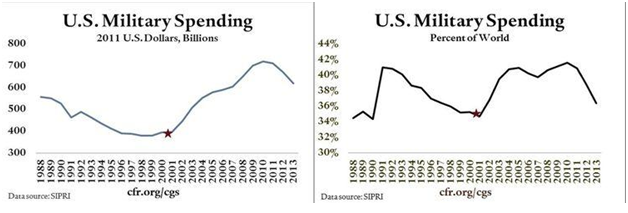
Wouldn’t you be ecstatic if you saw your household revenues increase by three times the inflation rate over4 a six year period? Or twice the inflation rate over ten years? I know I sure would. In nominal terms, defense spending, including VA, and DHS has ranged from $700 to $850 billion since 2008. True defense spending, including all the relevant agencies, increased by twice the inflation rate from 2004 to 2014.Īnd, if we look at growth from 2004 to 2010, a year before all those draconian cuts Heritage says we have, then we find that over that period, defense spending increased 60 percent, or three times the inflation rate over that period. If we take a look at the combined total of DHS, DoD, and VA spending, we find that as of 2014 - a period of military “decline” according to the Heritage Foundation - that military spending was up 50 percent from 2004 to 2014… But it wasn’t long before we saw a historically unprecedented levels of defense spending during the War on Terror (more on that later):Ĭurrently, our country’s defense spending is basically on par with levels seen during the height of the Vietnam War and during the Reagan military buildup. Once we reached the 1990s, defense spending declined somewhat after the end of the Cold War and during the Clinton years. We see two big spikes for the Korean and Vietnam wars, as well as another significant ramp-up under President Reagan in the 80s.

The peak of defense spending during the Iraq conflict was 5.66 percent GDP in 2010.ĭuring the 20th century, the two World Wars accounted for the two major peaks of defense spending: The last year in which defense spending hit 10 percent of GDP was 1968 at the height of the Vietnam War. It spiked at 41 percent in World War II, and again at nearly 15 percent of GDP during the Korean War.ĭefense spending exceeded 10 percent of GDP for one year in the 19th century and 19 years in the 20th century. It spiked at nearly 12 percent of GDP in the Civil War of the 1860s (not including spending by the rebels). There have been four major spikes in U.S. Since then, defense spending has never returned to anything less than 3.6% of GDP. government really didn’t spend that much on defense - only about 1% of GDP.Īfter the war, America found itself smack-dab in the middle of a global fight against Communism, and defense spending was more than 41% of GDP.

But just how much has our country spent on defense over the last 100 years?īefore WWII, and in times of peace, the U.S. So it’s pretty clear military expenses cover quite a wide range of stuff. Such expenditures include military and civil personnel, including retirement pensions of military personnel and social services for personnel operation and maintenance procurement military research and development and military aid. …All current and capital expenditures on the armed forces, including peacekeeping forces defense ministries and other government agencies engaged in defense projects paramilitary forces, if these are judged to be trained and equipped for military operations and military space activities. The World Bank defines military expenditure as: military accounts for a staggering 40% of global military spending, but this isn’t anything new, folks. The United States has been experiencing a century of extreme defense spending, and if we don’t slow down soon, this military spending could prove to be our country’s downfall. James Madison, Political Observations, 1795 War is the parent of armies from these proceed debts and taxes… known instruments for bringing the many under the domination of the few… No nation could preserve its freedom in the midst of continual warfare.” “Of all the enemies to public liberty war is, perhaps, the most to be dreaded because it comprises and develops the germ of every other.

A Century of Defense Spending In The United States


 0 kommentar(er)
0 kommentar(er)
